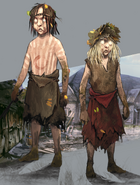Godling (Polish: bożątko) is a rare being capable of communicating in the common tongue.
They typically resemble a human child, except they have big bright eyes and pale blue skin.
Some godlings are known to tattoo themselves and they wear little when it comes to clothes apart from some adornments. Godlings usually live in woody and swampy areas, and aren't afraid of living close to monsters like drowners. They are easily confused with a bucca or lutin, and can be hurt (or killed) by an herb called Burdock.
Quick Answers

What is the definition of a Godling?

Godlings are rare beings that look like human children with large bright eyes and pale blue skin. They communicate in common language and typically inhabit woody and swampy areas. Godlings are territorial, providing care and protection to those living near their burrows. They are attracted to joy and innocence, often revealing themselves to children. They offer small services to those they care for, seeking respect and payment in food or discarded tools.
Provided by: Fandom
What physical characteristics distinguish a Godling from a human child?

Godlings, or bożątko in Polish, are rare beings resembling human children but with distinct physical characteristics. They have large, bright eyes of yellow to green hues and pale blue skin. Some Godlings have tattoos and typically wear minimal clothing with adornments. They inhabit woody and swampy areas, providing care and guardianship to nearby dwellers.
Provided by: Fandom
What is the typical habitat of a Godling?

Godlings, rare beings also known as bożątko, typically inhabit woody and swampy areas, often residing in burrows and moss-covered hollow stumps near human settlements. They coexist with monsters like drowners, despite their shy nature. Deeply rooted in their home territory, godlings perform acts of care and guardianship for nearby dwellers, both human and animal.
Provided by: Fandom
What kind of monsters are Godlings known to live close to?

Godlings, resembling children in behavior, inhabit woody and swampy regions. They coexist with monsters like drowners, showing no fear. As territorial guardians, they protect their surroundings and nearby inhabitants.
Provided by: Fandom
What are bucca and lutin that Godlings are often confused with?

Godlings, bucca, and lutin are woodland entities often mistaken for each other due to their similar behaviors and appearances. Once regarded as guardian spirits of peasant hamlets, they inhabit places like burrows and moss-covered hollow stumps near human settlements.
Provided by: Fandom
Notable godlings
Bestiary entry
- Not too long ago the areas around peasant hamlets were chock full of guardian spirits. Today it's nigh unto impossible to spot a brownie, bucca or lutin. And godlings, they are always the first to go. Such is the price we pay for civilization's forward march.
– From the preface to "The World We Have Lost," by Professor Dorregaray - Godlings (sometimes mistaken for lutin) are woodland creatures dwelling in burrows and moss-covered hollow stumps on the outskirts of human settlements. They are similar to children in behavior and appearance, and, like children, delight in mischief. Godlings are deeply rooted in their home territory and perform acts of care and guardianship to those dwelling near their burrows. They watch over people as well as animals, but, shy creatures by nature, they try to do so while remaining unseen. Godlings are drawn to joy and innocence, and so delight in the company of children and usually only show themselves to the young.
- These hard-working and clever creatures gladly perform small services for those in their care, asking only for respect and payment in the form of food or cast-off tools in return. They are easily offended by churlish, ungrateful or simply rude behavior. Godlings also treasure their peace and quiet. When the village a godling watches over becomes too populous or its inhabitants forget the old ways, it will abandon its burrow for good and walk off to destinations unknown.
Trivia
- Bożątko, as the godling is known in the native version of the game, is the diminutive form of ubożę or bożęta. It is the name of a usually benignant house spirit from Polish mythology, said to originate from the souls of deceased ancestors. This creature appears in the folklore of other Slavic countries as well but sometimes under different names, e.g. in Russian lands it was known as a domovik or domovoy.
Videos
Gallery
| |||||||||||||||||
| |||||||||||||||||
| |||||||||||||||||
| |||||||||||||||||
| |||||||||||||||||
| |||||||||||||||||
| |||||||||||||||||
| |||||||||||||||||
| |||||||||||||||||
| |||||||||||||||||
| |||||||||||||||||
